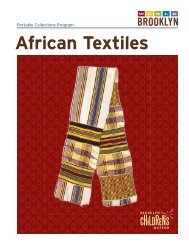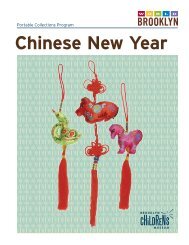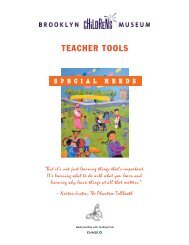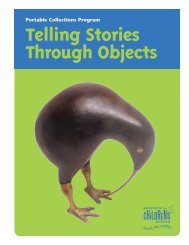What Are Masks For? - Brooklyn Children's Museum
What Are Masks For? - Brooklyn Children's Museum
What Are Masks For? - Brooklyn Children's Museum
Create successful ePaper yourself
Turn your PDF publications into a flip-book with our unique Google optimized e-Paper software.
ACTIVITY 4<br />
Grades 2–5<br />
Related Objects: All<br />
Make a Papier-Mâché Mask<br />
As your students learned in the previous activity, masks<br />
can be made from any number of materials. Papiermâché<br />
is one very common material, and is often used<br />
for making masks in Mexico, India, Indonesia, and China.<br />
Unfortunately, these masks are too fragile to be included<br />
in the <strong>Museum</strong> case. In this activity, students will construct<br />
and decorate a papier-mâché mask of their own<br />
design.<br />
Materials:<br />
• Wallpaper paste or flour<br />
• Water<br />
• Large bowls<br />
• Scissors<br />
• Hole-punch<br />
• Paint<br />
• Yam<br />
• Newspaper cut into strips<br />
• One pre-inflated baloon for each child<br />
• Pipe cleaners<br />
4 Have students repeat step 1 until they have covered<br />
one half of each balloon. Remind them not to cover<br />
the whole balloon.<br />
5 Stop for the day. Allow the paper strips to dry.<br />
6 On the second day, students should add a second<br />
layer of paper strips on top of the first dried layer by<br />
repeating steps 3–5.<br />
7 When the second layer is dry, have your students<br />
pop their balloons. The layers of paper should hold<br />
their shape, forming the mask.<br />
8 Assist your students in cutting two holes for the eyes.<br />
9 Students may add more layers of papier-mâché to<br />
the mask to give it strength, but they should always<br />
allow the mask to dry between layers. They can<br />
create strong facial features by building up layers.<br />
Remind them to leave the eyeholes uncovered.<br />
10 After the last layer of papier-mâché has dried, have<br />
your students decorate their masks with paint, fabric,<br />
or yarn.<br />
11 Have students punch holes in the sides of their masks,<br />
and attach yarn to create tie strings.<br />
<strong>What</strong> To Do:<br />
1 Mix the wallpaper paste or flour with water in a bowl<br />
until it reaches the consistency of pudding and all<br />
lumps have disappeared<br />
2 Place the newspaper strips and balloons next to the<br />
bowls.<br />
3 Demonstrate to your students how to take a strip of<br />
newspaper and pull it through the paste so that it is<br />
covered, but not dripping. Then place the strip on<br />
top of the balloon.<br />
Discussion Questions:<br />
• <strong>What</strong> sort of masks could you make using the papiermâché<br />
method? <strong>What</strong> are the pros and cons of using<br />
this material?<br />
• How did you choose to decorate your mask? Who or<br />
what does it represent?<br />
See page 16 for details on how this activity meets<br />
New York State Learning Standards.<br />
MASKS 11








